County Sligo: Difference between revisions
mNo edit summary |
|||
| Line 2: | Line 2: | ||
|name=County Sligo | |name=County Sligo | ||
|irish=Contae Shligigh | |irish=Contae Shligigh | ||
|map image= | |map image=Sligo Ireland (BI Sect 7).svg | ||
|picture=Rathcormacksligo.JPG | |picture=Rathcormacksligo.JPG | ||
|picture caption=Rathcormack | |picture caption=Rathcormack | ||
Latest revision as of 22:40, 18 January 2015
| County Sligo Irish: Contae Shligigh Republic of Ireland | |
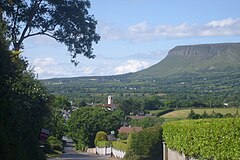 Rathcormack | |
|---|---|
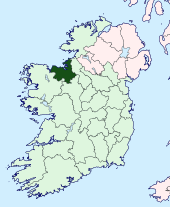
| |
| [Interactive map] | |
| Province: | Connaught |
| Area: | 709 square miles |
| Population: | 65,393 |
| County seat: | Sligo |
The County of Sligo is a shire on the Atlantic coast of Ireland, in the Province of Connaught. It is named after the town of Sligo. The population of the county is 65,393 according to the 2011 census.
Geography
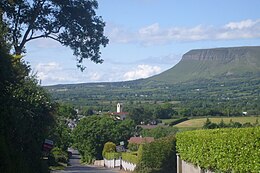
Sligo is the 22nd largest of Ireland's 32 counties in area and 26th largest in terms of population.[1] It is the fourth largest of Connaught's five counties in size and third largest in terms of population. The County borders County Mayo to the west, County Roscommon to the south and south-east and County Leitrim to the north-east.
Largest towns
- Sligo town 19,452
- Tubbercurry, 1,747
- Strandhill, 1,596
- Ballymote, 1,539
- Collooney, 1,369
Towns and villages
- Achonry
- Aclare
- Ballaghnatrillick
- Ballinafad
- Ballintogher
- Ballymote
- Ballysadare
- Beltra
- Bunninadden
- Carney
- Castlebaldwin
- Cliffony
- Cloonacool
- Collooney
- Coolaney
- Culfadda
- Dromore West
- Drumcliff
- Easky
- Enniscrone
- Geevagh
- Grange
- Gorteen
- Kilglass
- Keash
- Monasteraden
- Mullaghmore
- Riverstown
- Rosses Point
- Skreen
- Strandhill
- Toorlestraun
- Tubbercurry
History
The county was theoretically formed in 1585, but was not made a reality until after the chaos of the Nine Years' War had ended, in 1603. Its boundaries reflect the Ó Conchobhair Sligigh overlordship of Lower Connaught as it was at the time of the Elizabethan conquest.
This overlordship consisted of the tuatha, or territories, of Cairbre Drumcliabh, Tír Fhíacrach Múaidhe, Tír Ollíol, Luíghne, Corann and Cúl ó bhFionn. Each of these was subsequently made into an English-style barony, hence Carbury, Tireragh, Leyny, Tirerril. Corran and Coolavin. The capital of the newly shired county was placed at Sligo.
Archaeology
The megalithic cemetery of Carrowmore is located in County Sligo. It forms part of a huge complex of Stone Age remains connecting Carrowkeel in south Sligo to the Ox Mountains, to the Cuil Irra Peninsula, where Queen Maeve's tomb, Miosgán Médhbh, dominates the western skyline from the crest of Knocknarea Mountain. An archaeological recovery suggests the county may have been one of the earliest places of human settlement in Ireland.[2]
Mediæval
Famous mediæval manuscripts written in County Sligo include the Book of Ballymote, the Great Book of Lecan, and the Yellow Book of Lecan. The patron of the Annals of the Four Masters was Ferghal O Gadhra of Coolavin in south County Sligo.
Modern
Culture
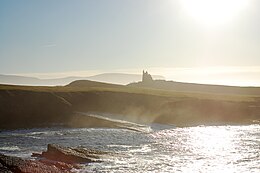
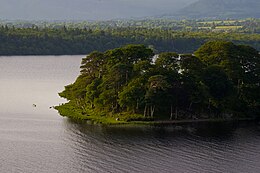
The poet and Nobel laureate William Butler Yeats (1865–1939) spent much of his childhood in northern Sligo and the county's landscapes (particularly the Isle of Innisfree, in Lough Gill) were the inspiration for much of his poetry. Yeats said, "the place that has really influenced my life most is Sligo." He is buried in North County Sligo, "Under Ben Bulben", in Drumcliff.
Music
County Sligo has a long history of traditional music. The south of the county is particularly noted with such musical luminaries as James Morrison, Michael Coleman, Paddy Killoran, Fred Finn, Peter Horan, Joe O'Dowd, Jim Donoghue, Martin Wynne, Oisín Mac Diarmada (of Téada), tin-whistle player Carmel Gunning and the band Dervish. The county has many traditional music festivals and one of the most well known is the Queen Maeve International Summer School, a traditional Irish Music summer school of music and dance which is held annually in August in Sligo Town. On the more contemporary music scene there are Westlife, Tabby Callaghan and The Conway Sisters who are from Sligo. Strandhill, about 5½ miles west of Sligo, hosts the Strandhill Guitar Festival [1] each year, featuring a wide variety of guitar music and musicians.
Sport
The county is home to League of Ireland Premier Division club Sligo Rovers, who have played home matches at The Showgrounds since they were founded in 1928. Brother Walfrid the founder of Celtic Football Club was born in Ballymote.
The county is represented in Gaelic Games by Sligo GAA.
People
- Ambrosio O'Higgins, 1st Marqués de Osorno – Spanish colonial administrator
- William Butler Yeats – poet
- Jack Butler Yeats – Artist
- Brother Walfrid – founder of Celtic FC
- Constance Markievicz – revolutionary Irish nationalist
- James Morrison – traditional music
- Michael Coleman – traditional music
- Sir George Stokes, 1st Baronet – mathematician, physicist
- Martin Moffat, recipient of the Victoria Cross
- Lola Montez – dancer, actress
- Marian Harkin – MEP
- Martin Savage – Irish republican
- Mary O'Hara – singer
- Michael Corcoran – Union Army general in the American Civil War
- Neil Jordan – film director
- Ray McSharry – former Tánaiste
- Tommy Fleming – singer
- Westlife – pop band
References
- ↑ Corry, Eoghan (2005). The GAA Book of Lists. Hodder Headline Ireland. pp. 186–191. ISBN 0-340-89695-7.
- ↑ C.Michael Hogan. 2011. Celtic Sea. Encyclopedia of Earth. Eds. P.Saundry & C.J.Cleveland. National Council for Science and the Environment. Washington DC
Outside links
| ("Wikimedia Commons" has material about Sligo County Sligo) |
- Collection of Sligo Landscape Photographs
- Map of Sligo
- Sligoheritage.com
- History of Sligo, County and Town By William Gregory Wood-Martin
- Song, "Beautiful Sligo" sung by Michael McGloin,YouTube Video, with images.
| Counties of the Republic of Ireland |
|---|
|
Carlow • Cavan • Clare • Cork • Donegal • Dublin • Galway • Kerry • Kildare • Kilkenny • Laois • Leitrim • Limerick • Longford • Louth • Mayo • Meath • Monaghan • Offaly • Roscommon • Sligo • Tipperary • Waterford • Westmeath • Wexford • Wicklow |
